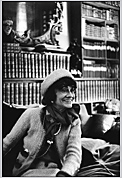|
Robert Flaherty, 1935
Carson McCullers and
John Huston, 1946
William Faulkner, 1947
Truman Capote, 1947
Coco Chanel, 1964
Alexander Calder, 1970 |
Introduction
When Henri Cartier-Bresson picked up his Leica in 1932, it was a miraculous new kind of camera, small and light, equipped with a sharp, fast lens and filled with a long roll of 35 mm film. This remains the kind of camera most of us know and use today, but before that time virtually all cameras were larger and more cumbersome. The amateur's Kodak, although easy to use, offered little control over composition, and the press photographer's Speed Graphic used large sheets of film that had to be loaded one at a time and often needed a bulky flash. Of course, ambitious photographers devised clever ways to get around their clumsy materials, choosing subjects that didn't move too much, counting on luck and quick reflexes to freeze motion, or perfecting the image in the darkroom, where it was easy to crop out awkward information and improve the composition.
Henri Cartier-Bresson was an aspiring painter and student of literature when he first saw Martin Munkacsi's brilliant photographs of runners, swimmers, and race-car drivers, which appeared in the new illustrated magazines being published in Germany and France. Through Munkacsi's work, Cartier-Bresson recognized how the new small cameras made it possible to capture spontaneous motion while creating beautiful compositions within the rectangular shape of a single frame of 35 mm film. He was also deeply influenced by the contemporary movement known as surrealism, which encouraged artists and writers to explore the meaning that lay hidden below the surface of everyday life. In the hands of the surrealists, photography became a way to reveal significance that would otherwise be invisible or lost. When captured in a photograph, a simple gesture, chance meeting, or mundane setting could convey great beauty or tragedy or humor.
Henri Cartier-Bresson is known for his ability to find these occasions and preserve them, using his camera to identify what has come to be called the "decisive moment." The act of making such photographs relies partly on intuition and partly on chance, but it also grows out of enormous discipline. For despite the spontaneous nature of his subjects, Henri Cartier-Bresson never abandoned his formal training as an artist. Each image is a complete composition within a single frame of film, and it cannot be cropped or altered without destroying the whole. This whole image can take many different forms, however. It is not unusual for one image to appear on the pages of a magazine, in a book, or enlarged and framed on a museum wall.
Cartier-Bresson is not alone when he calls portraiture "the one domain which photography has won away from painting." From the invention of photography in 1839, everyone recognized the camera's ability to render a technically accurate likeness of a face. But in the hands of Cartier-Bresson, a photographic portrait seems transparent, as if no photographer has intervened between the subject and the viewer. We might be eavesdropping on Coco Chanel as she laughs with delight, we might have surprised Carson McCullers and her companion, George Davis, stretched out on the lawn, or have strolled unannounced into William Faulkner's backyard. We feel that we know them, because Cartier-Bresson captures what seems to be the essence of their being, the way they look when they are most themselves. These images convey a palpable physical relationship between the viewer and the subject. To see through Cartier-Bresson's eyes, to stand in his shoes, we find ourselves poised on the threshold of a new discovery. In 1947, Lincoln Kirstein compared his method to "the preoccupied intensity of a fisherman playing to land a big catch or a boxer landing a knockout."
Henri Cartier-Bresson chose these portraits from many thousands of negatives made over six decades. The earliest images date from his travels to Mexico in 1934, and the most recent, a portrait of the British painter Lucien Freud, was made in 1997. As both artist and journalist, Cartier-Bresson met and photographed the world's leading artists, writers, and politicians. Many familiar faces appear here, alongside compelling portraits of anonymous men and women he encountered along the way. Cartier-Bresson photographed them all with the same endless curiosity, the same uncompromising eye. His portraits comprise an unrivaled record of our time, the way we look, the people we admire, and the secrets we try to keep_until he gently seizes them with his camera and turns them into art. |






